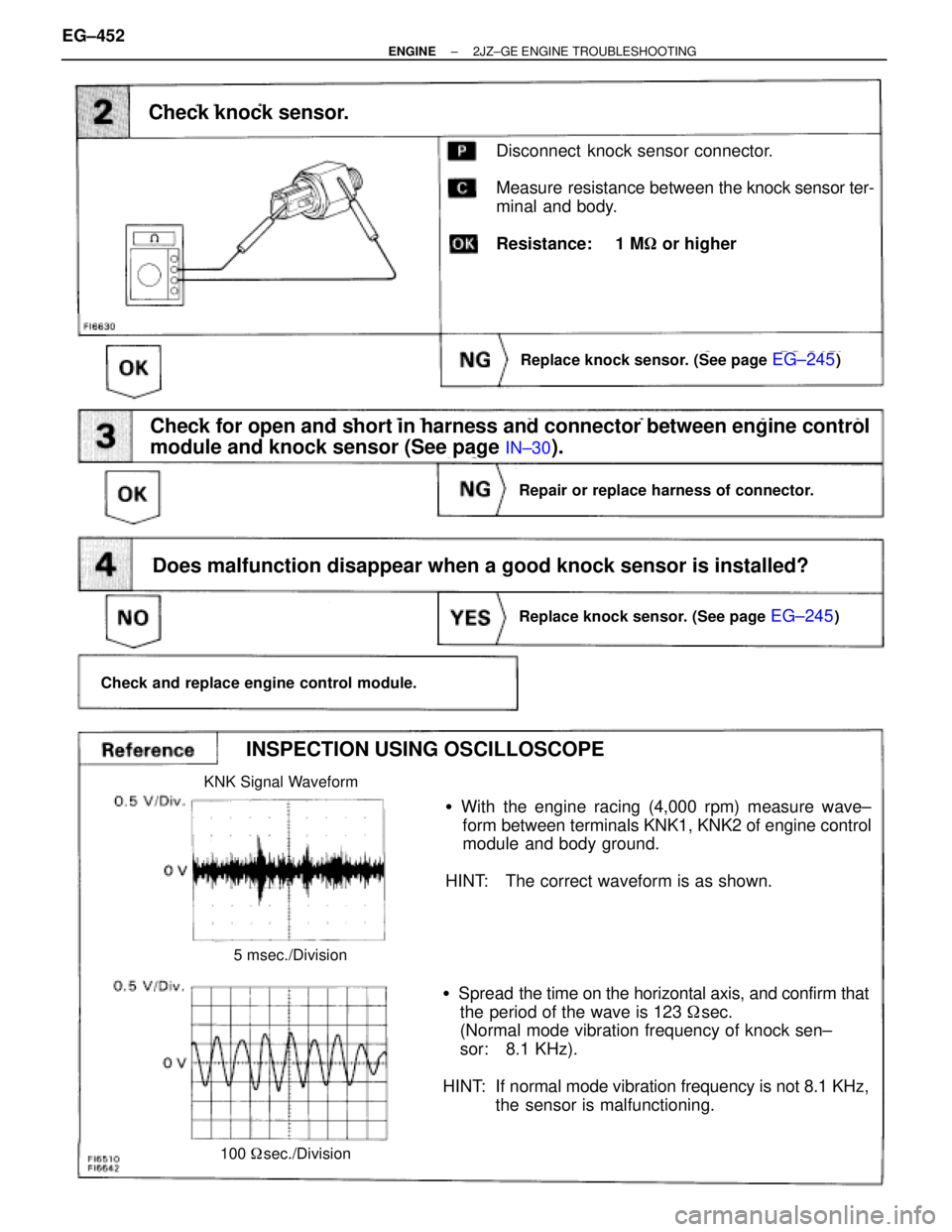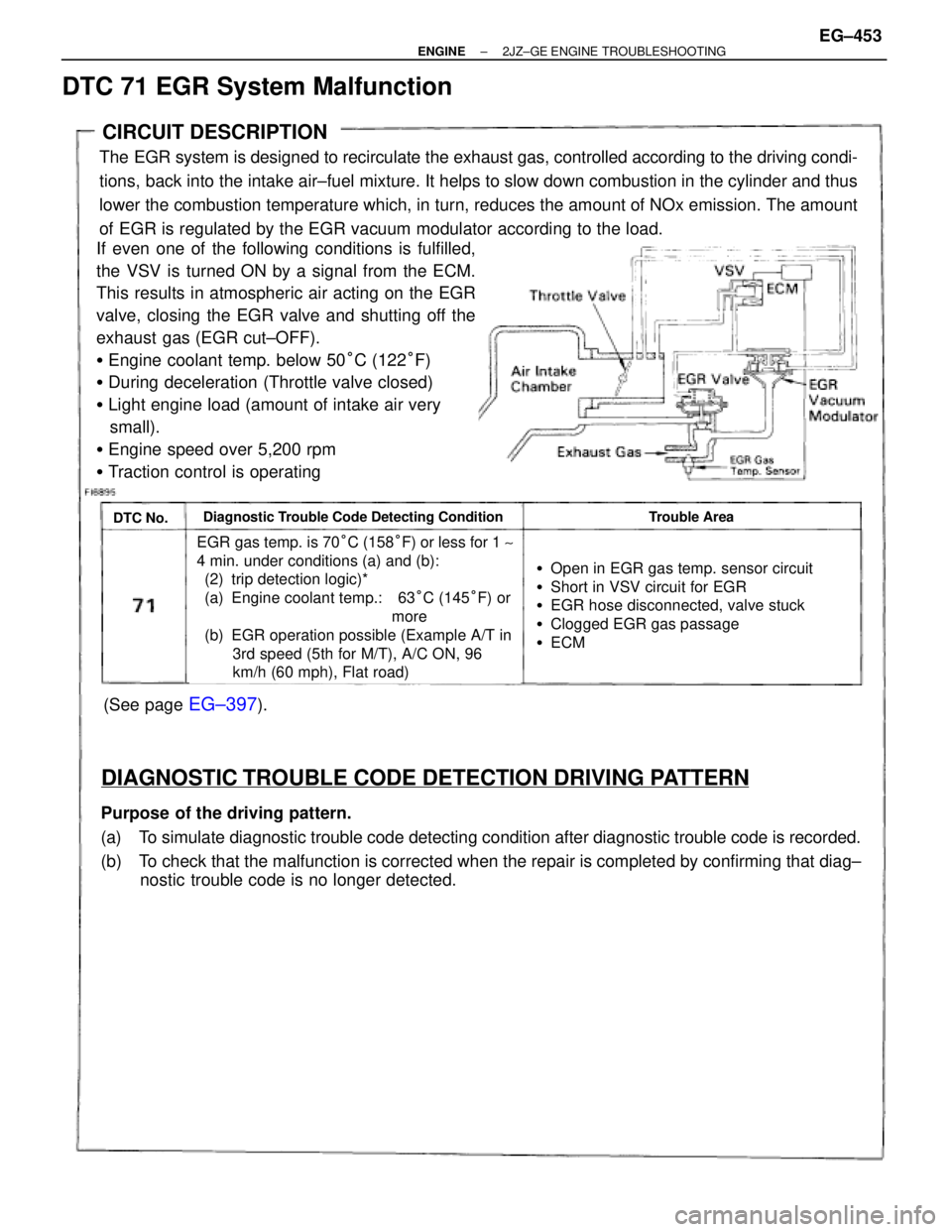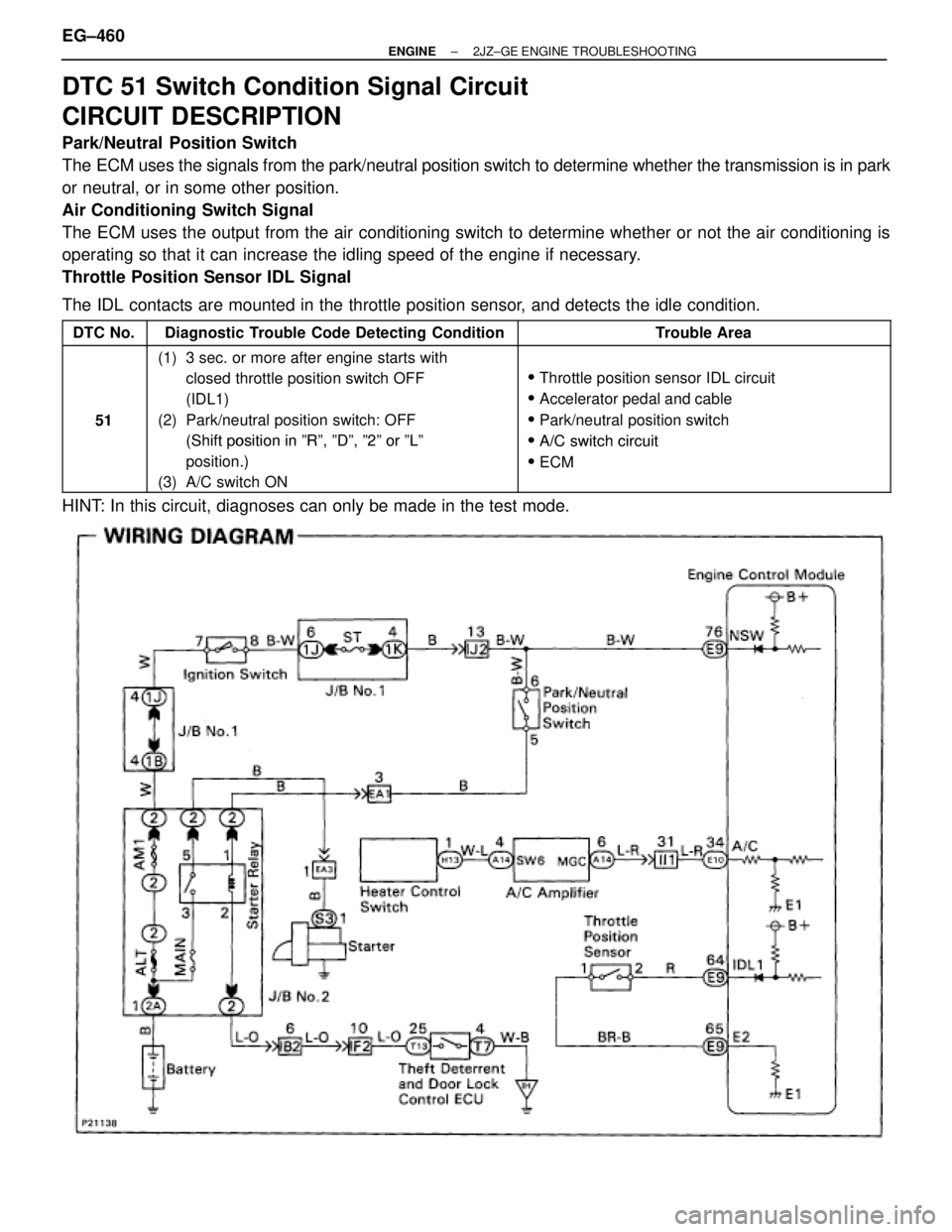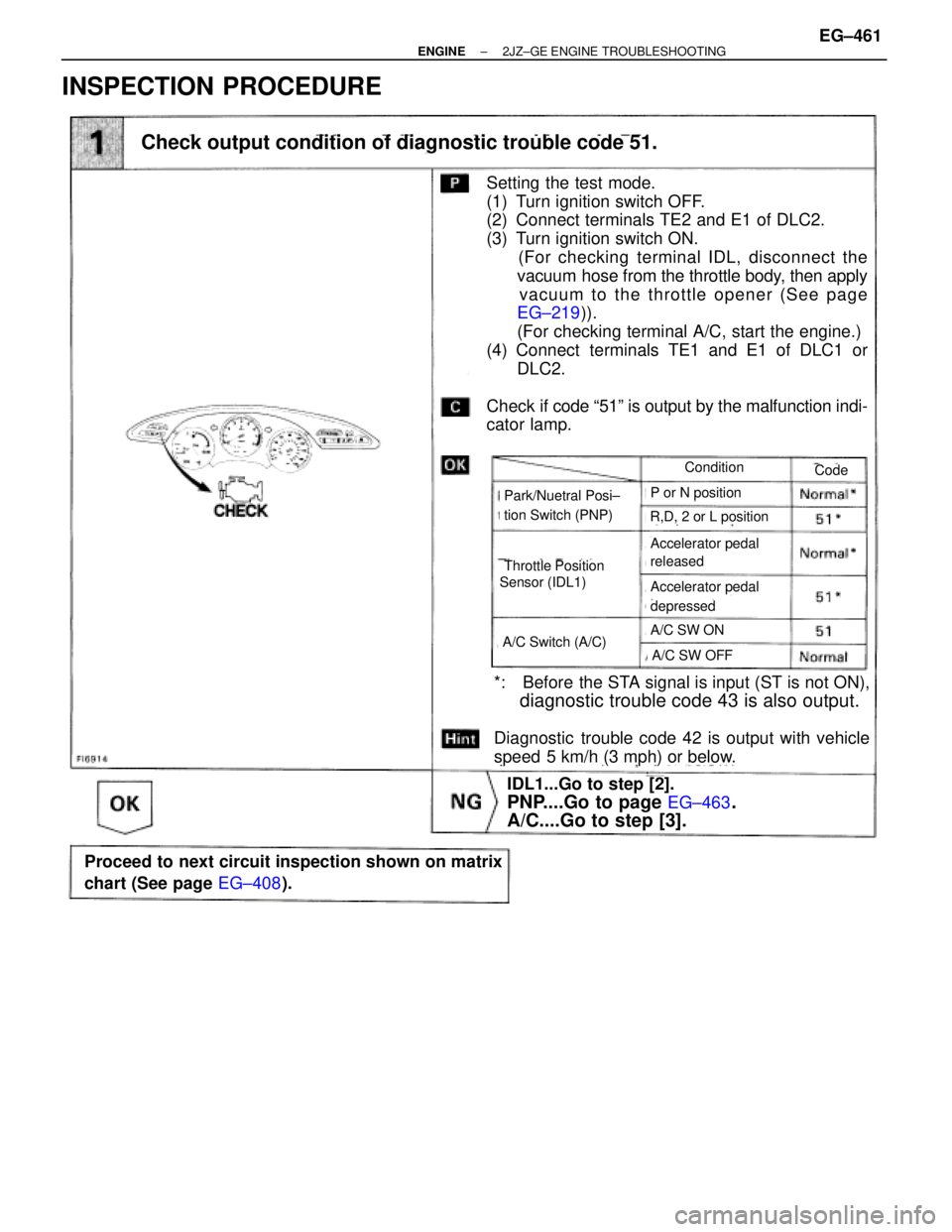Page 1959 of 2543
INSPECTION PROCEDURE
HINT: If diagnostic trouble code 52 is displayed, check No.1 knock sensor (for front side) circuit.
If diagnostic trouble code 55 is displayed, check No.2 knock sensor (for rear side) circuit.
If diagnostic trouble code 53 is displayed, replace engine control module.
(See page
EG±404)
Check continuity between terminals KNK1, KNK2 of engine control module
connector and body ground.
(1) Connect SST (check harness ªAº).
(See page EG±404)
SST 09990±01000
(2) Disconnect the engine control modulecon±
nectors.
Measure resistance between terminals KNK1,
KNK2 of engine control module connector and
body ground.
Resistance: 1 M� or higher
± ENGINE2JZ±GE ENGINE TROUBLESHOOTINGEG±451
Page 1960 of 2543

INSPECTION USING OSCILLOSCOPE
�With the engine racing (4,000 rpm) measure wave±
form between terminals KNK1, KNK2 of engine control
module and body ground.
HINT: The correct waveform is as shown.
�Spread the time on the horizontal axis, and confirm that
the period of the wave is 123 � sec.
(Normal mode vibration frequency of knock sen±
sor: 8.1 KHz).
HINT: If normal mode vibration frequency is not 8.1 KHz,
the sensor is malfunctioning.
KNK Signal Waveform
5 msec./Division
100 � sec./Division
Check knock sensor.
Disconnect knock sensor connector.
Measure resistance between the knock sensor ter-
minal and body.
Resistance: 1 M� or higher
Replace knock sensor. (See page EG±245)
Repair or replace harness of connector.
Replace knock sensor. (See page EG±245)
Check and replace engine control module.
Check for open and short in harness and connector between engine control
module and knock sensor (See page
IN±30).
Does malfunction disappear when a good knock sensor is installed?
EG±452± ENGINE2JZ±GE ENGINE TROUBLESHOOTING
Page 1961 of 2543

(See page EG±397).
CIRCUIT DESCRIPTION
The EGR system is designed to recirculate the exhaust gas, controlled according to the driving condi-
tions, back into the intake air±fuel mixture. It helps to slow down combustion in the cylinder and thus
lower the combustion temperature which, in turn, reduces the amount of NOx emission. The amount
of EGR is regulated by the EGR vacuum modulator according to the load.
If even one of the following conditions is fulfilled,
the VSV is turned ON by a signal from the ECM.
This results in atmospheric air acting on the EGR
valve, closing the EGR valve and shutting off the
exhaust gas (EGR cut±OFF).
�Engine coolant temp. below 50°C (122°F)
�During deceleration (Throttle valve closed)
�Light engine load (amount of intake air very
small).
�Engine speed over 5,200 rpm
�Traction control is operating
DTC No.Diagnostic Trouble Code Detecting ConditionTrouble Area
EGR gas temp. is 70°C (158°F) or less for 1 ~
4 min. under conditions (a) and (b):
(2) trip detection logic)*
(a) Engine coolant temp.: 63°C (145°F) or
more
(b) EGR operation possible (Example A/T in
3rd speed (5th for M/T), A/C ON, 96
km/h (60 mph), Flat road)
�Open in EGR gas temp. sensor circuit
�Short in VSV circuit for EGR
�EGR hose disconnected, valve stuck
�Clogged EGR gas passage
�ECM
DIAGNOSTIC TROUBLE CODE DETECTION DRIVING PATTERN
Purpose of the driving pattern.
(a) To simulate diagnostic trouble code detecting condition after diagnostic trouble code is recorded.
(b) To check that the malfunction is corrected when the repair is completed by confirming that diag±
nostic trouble code is no longer detected.
DTC 71 EGR System Malfunction
± ENGINE2JZ±GE ENGINE TROUBLESHOOTINGEG±453
Page 1962 of 2543
Malfunction: Open in EGR Gas Temp. Sensor Circuit
(Vehicle Speed)
(1)�Disconnect the EFI No.1 fuse (30A) for 10 sec. or more, with IG switch OFF. Initiate
���test mode (Connect terminal TE2 and E1 of data link connector 2 with IG switch
���OFF).
(2)�Start engine and warm up.
(3) Idle the engine for 3 min.
(4) With the A/C ON and transmission in 5th position (A/T in 3rd speed) drive at 88 ~ 96
km/h (55 ~ 60 mph) for 4 min. or less.
HINT: If a malfunction exists, the malfunction indicator lamp will light up during step (4).
NOTICE: If the conditions in this test are not strictly followed, detection of the malfunction
will not be possible. EG±454
± ENGINE2JZ±GE ENGINE TROUBLESHOOTING
Page 1964 of 2543
Check EGR system (See page Eg±168).
Remove EGR gas temp. sensor.
Measure resistance between terminals of EGR gas
temp. sensor connector.
Resistance: 64 Ð 97 k� at 50°C (122°F)
11 Ð 16 k� at 100°C (1212°F)
2 Ð 4 k� at 150°C (302°F)
Replace EGR gas temp. sensor.
Repair EGR system.
Replace EGR gas temp. sensor.
Repair or replace harness or connector.
Check and replace engine control module.
Check resistance of EGR gas temp. sensor.
Check for open in harness and connector between EGR gas temp. sensor
and engine control module. (See page
IN±30)
EG±456± ENGINE2JZ±GE ENGINE TROUBLESHOOTING
Page 1968 of 2543

DTC 51 Switch Condition Signal Circuit
CIRCUIT DESCRIPTION
Park/Neutral Position Switch
The ECM uses the signals from the park/neutral position switch to determine whether the transmission is in park
or neutral, or in some other position.
Air Conditioning Switch Signal
The ECM uses the output from the air conditioning switch to determine whether or not the air conditioning is
operating so that it can increase the idling speed of the engine if necessary.
Throttle Position Sensor IDL Signal
The IDL contacts are mounted in the throttle position sensor, and detects the idle condition.
����� �����DTC No.���������������� ����������������Diagnostic Trouble Code Detecting Condition����������������� �����������������Trouble Area
����� �
���� �����
���������������� �
��������������� ����������������
(1) 3 sec. or more after engine starts with
closed throttle position switch OFF
(IDL1)
����������������� �
���������������� ������������������ Throttle position sensor IDL circuit
Alt dldbl����� �
���� �����51
���������������� �
��������������� ����������������
(IDL1)
(2) Park/neutral position switch: OFF
(Shiftposition inºRººDºº2ºorºLº
����������������� �
���������������� �����������������
� Accelerator pedal and cable
� Park/neutral position switch
�A/C switch circuit����� �
���� �����
���������������� �
��������������� ����������������
(Shift position in ºRº, ºDº, º2º or ºLº
position.)
(3) A/C switch ON����������������� �
���������������� �����������������
� A/C switch circuit
� ECM
HINT: In this circuit, diagnoses can only be made in the test mode.
EG±460± ENGINE2JZ±GE ENGINE TROUBLESHOOTING
Page 1969 of 2543

INSPECTION PROCEDURE
(EG±463).
Check output condition of diagnostic trouble code 51.
*: Before the STA signal is input (ST is not ON),
diagnostic trouble code 43 is also output.
Diagnostic trouble code 42 is output with vehicle
speed 5 km/h (3 mph) or below.
Setting the test mode.
(1) Turn ignition switch OFF.
(2) Connect terminals TE2 and E1 of DLC2.
(3) Turn ignition switch ON.
(For checking terminal IDL, disconnect the
vacuum hose from the throttle body, then apply
vacuum to the throttle opener (See page
EG±219)).
(For checking terminal A/C, start the engine.)
(4) Connect terminals TE1 and E1 of DLC1 or
DLC2.
Check if code ª51º is output by the malfunction indi-
cator lamp.
Proceed to next circuit inspection shown on matrix
chart (See page EG±408).
IDL1...Go to step [2].
PNP....Go to page EG±463.
A/C....Go to step [3].
Condition
Throttle Position
Park/Nuetral Posi±
Code
tion Switch (PNP)
P or N position
released
R,D, 2 or L position
Accelerator pedal
Accelerator pedal
depressed
A/C SW ON
A/C SW OFFA/C Switch (A/C)
Sensor (IDL1)
± ENGINE2JZ±GE ENGINE TROUBLESHOOTINGEG±461
Page 1970 of 2543
(See page EG±404)
Check throttle position sensor.
(1) Disconnect throttle position sensor connector.
(2) Disconnect the vacuum hose from the throttle
body. than apply vacuum to the throttle opener
(See page EG±219).
Measure resistance between terminals 2 (IDL1)
and 1 (E2) of throttle position sensor connector.
Adjust or replace throttle position sensor.
(See page
EG±223)
Check and repair harmless or connector between en-
gine control module and throttle position sensor.
Check voltage between terminal A/C of engine control module connector and
body ground.
(1) Connect SST (check harness ªAº).
(See page EG±404)
SST 09990±01000
(2) Start the engine.
Measure voltage between terminal A/C of engine
control module and body ground.
Check A/C compressor circuit.
(See page AC±62)
Check and replace engine control module.
Throttle Valve
Fully closed
Opened
Less than 0.5 k�
1 M� or higher
Resistance
EG±462± ENGINE2JZ±GE ENGINE TROUBLESHOOTING